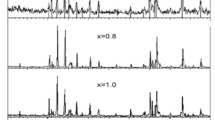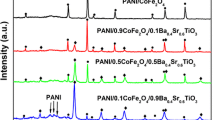Abstract
This paper is to study the dielectric properties and microwave absorption of rice husk ash/polyester (RHAP) composites. The RHAP composites prepared with different weight ratio (40–80 wt. %) of rice husk ash (RHA) loading into polyester was fabricated. A rectangular waveguide transmission line method was used to measure the dielectric properties of the RHAP composites. The RHAP samples were designed and simulated with different thickness and percentage of RHA loading by using Computer Simulation Technology Microwave Studio (CST-MWS) software. The materials, their dielectrics properties measurement and microwave absorption result over 12.4–18 GHz (Ku-Band) frequency range are discussed. The dielectric properties of composites increase with increasing loading the RA wt%. The RHAP sample with different thickness was investigated in Ku-Band. The microwave absorption was up to 99.84 %, using 80 % loading of RHA with thickness 15 mm at 13.81 GHz, and showing the RHAP composites is applicable as microwave absorber.
Access provided by Autonomous University of Puebla. Download conference paper PDF
Similar content being viewed by others
Keywords
These keywords were added by machine and not by the authors. This process is experimental and the keywords may be updated as the learning algorithm improves.
1 Introduction
Microwave absorbers typically consist of unique materials with their properties which absorb electromagnetic (EM) waves. To design of microwave absorber requires specific materials properties, such as dielectric and magnetic properties [1, 2]. The effectiveness of the microwave absorber depends on the dielectric and/or magnetic materials loading in the composite. Recent years, agriculture wastes materials have been reuse as microwave absorbing composites include oil palm, sugar bagasse, rubber tire dust, and rice husk [3–5]. RHA is an industrial waste obtained after burning the rice husks in furnace, open air or as fuel generate energy. RHA has been used in adsorbent application for oils and chemicals [6].
In this paper, a type of RHA as loading in polyester resin for application as microwave was investigated. The RHA-polyester (RHAP) composites of different weight ratio of RHA loading are described. Dielectric properties and microwave absorption of the composites have been evaluated. The RHA/polyester (RHAP) was composites with difference loading of RHA from 40 to 80 wt. % of weight ratio. The dielectric properties (ε r = ε r ′ – jε r ″) of RHAP samples are measured and investigated in Ku-band. The ε ’ r is called dielectric constant where is describes the ability of a material to store electromagnetic wave, whereas the loss factor, ε r ″ is describes the ability of a material convert the electromagnetic wave into heat and dissipated [7, 8].
2 Sample Preparations
To form the composites, raw RHA were mixed with polyester and methyl-ketone-polymer (MEKP). The RHAP composite were filled into waveguide sample holder to form into rectangular shape for WR-62 waveguide. Figure 1 shows the fabricated sample filled into WR-62 waveguide sample holder to conduct measurement. The size of the RHAP samples was fabricated in 15.799 × 7.899 × 5 mm3.
3 Experimental
3.1 Dielectric Properties Measurement
Rectangular waveguide transmission line technique was used to measure the dielectric of RHAP samples. In this measurement, the calibration technique TRL (through-reflect-line) applied is to minimize the residual errors of the measurements. The Agilent 85071E software is to measure the dielectric properties from transmission and reflection coefficient [9]. A pair of coaxial cable was connected to Agilent E8362B performance network analyzer and the coaxial cables were connected to the two waveguide. The sample holder was place between the two waveguide adaptors.
3.2 Simulation
The size RHAP samples were designed to be 300 × 300 mm2 (length × width) to evaluate the microwave absorption. To define the dielectric properties of the material in the CST simulation, the dielectric properties of RHAP samples were obtained from the dielectric properties measurement. RHAP sample with 80 % RHA loading was tested with different thickness of 5, 10, 15, and 20 mm. The size of aluminum plate was designed 300 × 300 × 5 mm3 (length × width × thickness) was used as metal back plate which placed at bottom of the RHAP flat absorber shown in Fig. 2. The purpose of the aluminum plate is to reflect back EM waves where the EM waves could not penetrate through the aluminum plate. The RHAP samples were simulated in normal incidence plane wave with different thickness and various weight ratio of RHA loading by using Computer Simulation Technology Microwave Studio (CST-MWS).
The reflection loss RLdB of the sample was calculated in decibel by using Eq. (1) [10]:
RLsample is referring to reflection loss of the samples with the metal back plate. RLref is the reflection loss (RL) of the aluminum as the reference, fully reflected (RLref ≈ 0 dB). The formula to calculate the percentage of microwave absorption can refer to Eq. (2) [11];
Where RLlinear is the RL expressed in linear form.
4 Results and Discussion
4.1 Dielectric Properties
The measured dielectric properties of RHAP composites versus frequency were shown in Fig. 3a, b. From the results, the dielectric constant (ε r ′) and loss factor, (ε r ″) of the composites increased with increasing RHA loading in the composites over the measured frequency region.
The 50 % RHA loading has the lowest average values of ε r ′ = 3.62 and ε r ″ = 0.24 compare with 60, 70, and 80 % RHA loading. For 60 % RHA loading, average values of ε r ′ and ε r ″ are 3.89 and 0.30 respectively. Figure 3a, b clearly shows that the RHA loading increase to 70 %, the average values of dielectric constant and loss factor also increased by 0.54 and 0.11 compared to 60 % RHA loading. The 80 % RHA loading has the highest average values of ε r ′ = 4.80 and ε r ″ = 0.47. From the analysis show increasing the weight ratio of RHA loading in the composites can enhance dielectric properties of the RHAP composites. Table 1 shows the average values of dielectric constant and loss factor of the different RHA loading over 12.4–18 GHz frequency range.
4.2 Reflection Loss and Microwave Absorption
The plane wave for evaluate RHAP samples performance were carried out in the time domain solver using CST Microwave studio. The reflection loss with different wt% (50, 60, 70, and 80 %) of RHA loading was simulated and evaluated. The reflection loss of different RHA loading in the composites was shown in Fig. 4.
Figure 4 shows the 80 % RHA loading with 15 mm thickness has two minimum RL peak < −10 dB; first peak = −28.4 dB at 13.81 GHz and second peak = −18.82 dB at 17.72 GHz. For 70 % RHA loading, the RL < −20 dB is over 14.29–14.46 GHz. Besides, the 60 % RHA loading only have the RL < −10 dB (>90 % absorption) between 14.82 and 15.60 GHz bandwidth. The 50 % RHA loading do not has microwave absorption more than 90 % with thickness 15 mm, but it has the maximum absorption 89.76 % at 14.85 GHz. The results clearly show that the minimum peak of RL was shift to lower frequency with increasing the wt% RHA loading. The RL and microwave absorption with 15 mm thickness of different RHAP samples were shown in Table 2.
Figure 5 shows the reflection loss determined in the single layer of 80 % RHA loading samples with different thickness (5, 10, 15, and 20 mm). The 80 % RHA loading samples were simulated with different thickness.
From the results, the reflection loss minimum peak value and bandwidth change with the different thickness of 80 % RHA loading. The minimum absorption with different thickness of 80 % RHA loading was showed in Table 3. When increased the thickness of the 80 % RHA loading, the minimum peak was shift to lower frequency. Different thickness of the 80 % RHA loading has different microwave absorption more than 90–99 % at certain frequency. For thickness 15 and 20 mm, both of the thicknesses have two minimum peaks. The happen due to the quarter wavelength and impedance matching.
5 Conclusions
In this paper, the rice husk ash (RHA) have found considerable as microwave absorber due to their carbon content and dielectric properties. RHAP samples with different weight ratio (50, 60, 70, 80 wt. %) of RHA were fabricated and simulated. The dielectric properties of RHAP samples were measured with rectangular waveguide transmission technique support by Agilent 85071E software in 12.4–GHz. Single layer microwave absorber with backed by aluminum plate was simulated and designed in CST-MWS. This work clearly shows that the values of dielectric constant and loss factor increase by increasing the loading of RHA into the composites. The reflection loss of 80 % RHA shows good absorption with −28.4 dB (99.84 %) at 13.81 GHz and 90 % absorption (RL < −10 dB) at 13.44–14.23 GHz and 17.28–18 GHz of frequency bandwidth. The results of reflection loss show RHAP composite can absorb microwave in frequency range 12.4–18 GHz. The reflection loss and absorption results show that the RHAP composites are suitable apply as microwave absorber.
References
Abbas, S., Mahesh Chandra, M., Verma, A., Chatterjee, R., Goel, T.C.: Complex permittivity and microwave absorption properties of a composite dielectric absorber. Compos. A Appl. Sci. Manuf. 37, 2148–2154 (2006)
Yu, X., Lin, G., Zhang, D., He, H.: An optimizing method for design of microwave absorbing materials. Mater. Des. 27, 700–705 (2006)
Nornikman, H., Malek, M.F.B.A., Ahmed, M., Wee, F.H., Soh, P.J., Azremi, A., Ghani, S.A., Hasnain, A., Taib, M.N.: Setup and results of pyramidal microwave absorbers using rice husks. Prog. Electromagn. Res. 111, 141–161 (2011)
Nornikman, H., Malek, M.F.B.A., Soh, P.J., Azremi, A.A.H., Wee, F.H., Hasnain, A.: Parametric study of pyramidal microwave absorber using rice husk. Prog. Electromagn. Res. 104, 145–166 (2010)
Zahid, L., Nornikman, M.F.B.A.M.H., Mohd Affendi, N.A., Ali, A., Hussin, N., Ahmad, B.H., Abdul Aziz, M.Z.A.: Development of pyramidal microwave absorber using sugar cane bagasse (scb). Prog. Electromagn. Res. 137, 687–702 (2013)
Foo, K., Hameed, B.: Utilization of rice husk ash as novel adsorbent: a judicious recycling of the colloidal agricultural waste. Adv. Colloid Interface Sci. 152, 39–47 (2009)
Lee, Y.S., Cheng, E.M., Liu, W.W., You, K.Y., Iqbal, M.N., Wee, F.H., Khor, S.F., Zahid, L., Haji Abd Malek, M.F.B.: Experimental determination of the performance of rice husk-carbon nanotube composites for absorbing microwave signals in the frequency range of 12.4–18 GHz. Prog. Electromagn. Res. 140, 795–812 (2013)
Oyharçabal, M., Olinga, T., Foulc, M.P., Lacomme, S., Gontier, E., Vigneras, V.: Influence of the morphology of polyaniline on the microwave absorption properties of epoxy polyaniline composites. Compos. Sci. Technol. 74, 107–112 (2013)
Agilent Technical Overview.: Agilent Technical Overview. Agilent 85071E Materials Measurement Software. Agilent literature number 5988-9472EN (2012)
Dai, Y., Sun, M., Liu, C., Li, Z.: Electromagnetic wave absorbing characteristics of carbon black cement-based composites. Cement Concr. Compos. 32, 508–513 (2010)
Wang, Z., Zhao, G.-L.: Microwave Absorption properties of carbon nanotubes-epoxy composites in a frequency range of 2–20 GHz. Open J. Compos. Mater. 3, 17 (2013)
Author information
Authors and Affiliations
Corresponding author
Editor information
Editors and Affiliations
Rights and permissions
Copyright information
© 2015 Springer International Publishing Switzerland
About this paper
Cite this paper
Lee, Y.S. et al. (2015). Composites Based on Rice Husk Ash/Polyester for Use as Microwave Absorber. In: Sulaiman, H., Othman, M., Abd. Aziz, M., Abd Malek, M. (eds) Theory and Applications of Applied Electromagnetics. Lecture Notes in Electrical Engineering, vol 344. Springer, Cham. https://doi.org/10.1007/978-3-319-17269-9_5
Download citation
DOI: https://doi.org/10.1007/978-3-319-17269-9_5
Published:
Publisher Name: Springer, Cham
Print ISBN: 978-3-319-17268-2
Online ISBN: 978-3-319-17269-9
eBook Packages: EngineeringEngineering (R0)









